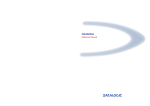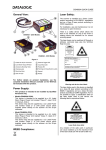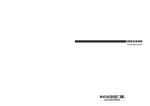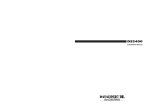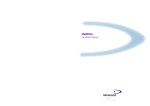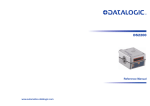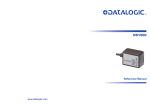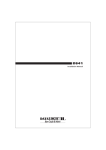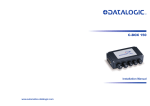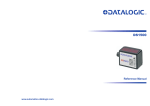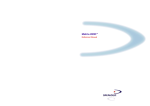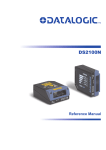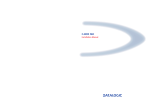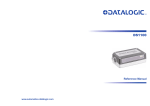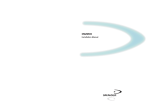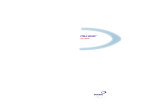Download Datalogic Laser Barcode Reader DS4600A-2XX5 Installation manual
Transcript
DS4600A Reference Manual DS4600A Reference Manual DS4600A INSTALLATION MANUAL DATALOGIC S.p.A. Via Candini 2 40012 – Lippo di Calderara di Reno Bologna - Italy DS4600A Reference Manual Ed.: 06/2003 ALL RIGHTS RESERVED Datalogic reserves the right to make modifications or improvements without prior notification. Datalogic shall not be liable for technical or editorial errors or omissions contained herein, nor for incidental or consequential damages resulting from the use of this material. Product names mentioned herein are for identification purposes only and may be trademarks and or registered trademarks of their respective companies. Datalogic S.p.A. 2003 04/06/03 CONTENTS GUIDE TO INSTALLATION ......................................................................... v GENERAL VIEW ..........................................................................................vi SAFETY PRECAUTIONS............................................................................vii Laser Safety.................................................................................................vii Power Supply................................................................................................ix 1 1.1 1.2 1.3 1.4 GENERAL FEATURES ................................................................................ 1 Introduction ................................................................................................... 1 Description .................................................................................................... 2 Available Models........................................................................................... 4 Accessories................................................................................................... 4 2 2.1 2.2 2.3 2.3.1 2.3.2 2.3.3 2.3.4 2.3.5 2.4 2.5 2.5.1 2.5.2 2.5.3 2.5.4 2.5.5 2.6 INSTALLATION............................................................................................ 5 Package Contents......................................................................................... 5 Mechanical Installation.................................................................................. 6 Electrical Connections .................................................................................. 8 Power Supply................................................................................................ 9 Main Serial Interface ................................................................................... 10 RS232 Interface .......................................................................................... 10 RS485 Full-Duplex Interface ....................................................................... 12 RS485 Half-Duplex Interface ...................................................................... 13 20 mA Current Loop (INT-24 Accessory Only)............................................ 15 Auxiliary RS232 Interface............................................................................ 16 Inputs ......................................................................................................... 17 Outputs ....................................................................................................... 19 Positioning .................................................................................................. 20 Typical Layouts ........................................................................................... 21 Point-to-Point .............................................................................................. 22 Pass Through.............................................................................................. 23 RS232 Master/Slave ................................................................................... 24 RS485 Master/Slave ................................................................................... 25 Multiplexer................................................................................................... 26 User Interface ............................................................................................. 27 3 3.1 3.1.1 3.2 3.2.1 3.2.2 READING FEATURES ............................................................................... 28 Advanced Code Reconstruction.................................................................. 28 Tilt Angle for Advanced Code Reconstruction............................................. 29 Decoding Capacity in Linear Mode ............................................................. 30 Step Ladder Mode ...................................................................................... 30 Picket Fence Mode ..................................................................................... 31 iii 3 3.3 3.4 READING FEATURES Performance ............................................................................................... 32 Reading Diagrams ...................................................................................... 34 4 4.1 MAINTENANCE.......................................................................................... 43 Cleaning...................................................................................................... 43 5 TECHNICAL FEATURES ........................................................................... 44 iv GUIDE TO INSTALLATION The following can be used as a checklist to verify all of the steps necessary for complete installation of the DS4600A scanner. 1) Read all information in the section "Safety Precautions" at the beginning of this manual. 2) Correctly position and mount the scanner for barcode reading according to the information in paragraphs 2.2, 2.4 and 3.4. 3) Provide correct system cabling according to the signals necessary for your application (see the applicable sub-paragraphs under 2.3). 4) Install the WinHost Configuration program from the CD. Upon successful completion of the installation, the readme file is opened, giving details about how to get started configuring your scanner. See also the Guide to Rapid Configuration link in the Help On-Line. Specific parameter details are also available in the Help On Line by pressing F1. Fine tuning of the scanner position for barcode reading can be accomplished using the Test Mode as described in WinHost. NOTE The installation is now complete. v GENERAL VIEW DS4600A 12 1 11 2 5 10 4 3 DS4600A - 2XXX Models 6 2 7 9 DS4600A - 3XXX Models 8 Figure A vi 1 Cable with 25-pin Connector 7 External Trigger LED 2 Laser Beam Output Window 8 Good Read LED 3 Accessory Mounting Holes 4 Warning Label 9 Ready LED 10 Warning and Classification Labels 5 Mounting Holes 11 Keypad 6 Data TX LED 12 Display SAFETY PRECAUTIONS LASER SAFETY The following information is provided to comply with the rules imposed by international authorities and refers to the correct use of the DS4600A scanner. Standard Regulations This scanner utilizes a low-power laser diode. Although staring directly at the laser beam momentarily causes no known biological damage, avoid staring at the beam as one would with any very strong light source, such as the sun. Avoid that the laser beam hits the eye of an observer, even through reflective surfaces such as mirrors, etc. This product conforms to the applicable requirements of both EN 60825-1 and CDRH 21 CFR 1040 at the date of manufacture. The scanner is classified as a Class 2 laser product according to EN 60825-1 regulations and as a Class II laser product according to CDRH regulations. There is a safety device which allows the laser to be switched on only if the motor is rotating above the threshold for its correct scanning speed. The laser beam can be switched off through a software command (see also the WinHost Help On Line). WARNING Use of controls or adjustments or performance of procedures other than those specified herein may result in exposure to hazardous visible laser light. vii The laser light is visible to the human eye and is emitted from the window on the front of the scanner (Figure A, 2). Warning labels indicating exposure to laser light and the device classification are applied onto the body of the scanner (Figure A, 4 and 10). DATALOGIC S.p.A. Via Candini, 2 40012 LIPPO DI CALDERARA (BO) ITALY Model No. Serial No. Volt Amp. Manufactured This product conforms to the applicable requirements of 21CFR1040 at the date of manufacture. LASER LIGHT DO NOT STARE INTO BEAM CLASS 2 LASER PRODUCT MAXIMUM OUTPUT RADIATION 1 mW EMITTED WAVE LENGTH 630~680 nm TO IEC 825-1 (1993) Warning and device class labels For installation, use and maintenance it is not necessary to open the scanner. The laser diode used in this device is classified as a class 3B laser product according to EN 60825-1 regulations and as a Class IIIb laser product according to CDRH regulations. As it is not possible to apply a classification label on the laser diode used in this device, the following label is reproduced here: LASER LIGHT AVOID EXPOSURE TO BEAM CLASS 3B LASER PRODUCT MAX. OUTPUT RADIATION 30 mW EMITTED WAVE LENGTH 630~680 nm TO IEC 825-1 (1993) Laser diode class label Any violation of the optic parts in particular can cause radiation up to the maximum level of the laser diode (30 mW at 630 to 680 nm). viii POWER SUPPLY - This product is intended to be installed by Qualified Personnel only. - Model DS4600A-XXX0: This device is intended to be supplied by a UL Listed Direct Plug-in Power Unit marked "Class 2", rated 10-30 V, minimum 0.60 A. This device may also be supplied by a UL Listed Power Unit with a "Class 2" or LPS power source which supplies power directly to the scanner via the 25-pin connector. - Model DS4600A-2XX5: This device is intended to be supplied by a UL Listed Direct Plug-in Power Unit marked "Class 2", rated 24 V, minimum 0.50 A. This device may also be supplied by a UL Listed Power Unit with a "Class 2" or LPS power source which supplies power directly to the scanner via the 25-pin connector. See par. 2.3.1 for correct power supply connections. ix x GENERAL FEATURES 1 1.1 1 GENERAL FEATURES INTRODUCTION The DS4600A is a compact laser scanner complete with decoder designed and produced to be a flexible and affordable solution for all medium range materials handling applications. Standard Application Program A Standard Application Program is factory-loaded onto the DS4600A. This program controls barcode reading, serial port interfacing, data formatting and many other operating and control parameters. It is completely user configurable from a host computer using the WinHost interface utility program provided on CD with the scanner or using the Host Mode programming procedure, by ESC sequences via the serial interface. There are four different programmable operating modes to suit various barcode reading system requirements. Included in these is a test mode to verify the reading features and exact positioning of the scanner without using external tools. Programmability If your requirements are not met by the Standard Application Program, Custom Application Programs can be developed by your local Datalogic distributor. 1 DS4600A 1 1.2 DESCRIPTION Some of the main features of this scanner are given below: • long-range reading • scanning speed 800 scans/sec • completely configurable from host computer • 2 serial communication interfaces • reads most popular codes • supply voltage from 10 to 30 Vdc • test mode to verify the reading features and exact positioning of the scanner without the need for external tools • configurable in different operating modes to suit the most various barcode reading system requirements • code verifier • possibility to detect the position of the label in the scan line The DS4600A scanner uses a solid state laser diode as a light source; the light emitted has a wavelength between 630 and 680 nm. Refer to the section "Safety Precautions" at the beginning of this manual for information on laser safety. The reader is contained in a rugged aluminum housing; the mechanical dimensions are 101 x 83.5 x 42 mm and it weighs about 615 g. The protection class of the enclosure is IP65, therefore the reader is particularly suitable for industrial environments where high protection against harsh external conditions is required. 2 GENERAL FEATURES 1 Electrical connection is provided through a cable on the side of the reader; this cable is terminated with a 25-pin connector (see Figure A, 1). The laser beam output window is on the right hand side of the scanner (Figure A, 2). A security system allows the laser to activate only once the motor has reached the correct rotational speed; consequently the laser beam is generated after a slight delay from the power on of the scanner. The four LEDs on the left hand side of the scanner indicate the following: READY (red), indicates the reader is connected to the power supply and the startup was successful. If the startup is not successful, this LED blinks. (Figure A, 9). GOOD READ (red), is used to signal successful barcode decoding. It is also used in Test mode to signal the decoding percentage (for details refer to the WinHost Help On Line). (Figure A, 8). EXT TRIG (yellow), indicates external trigger activity (for details refer to par. 2.3.4. (Figure A, 7). TX DATA (green), indicates data transmission on the main serial output line. (Figure A, 6). The screw holes on the body of the reader are for mechanical fixture (Figure A, 5); the screw holes shown in Figure A, 3 are to attach accessories such as the optional 90° mirror. 3 DS4600A 1 1.3 AVAILABLE MODELS The DS4600A scanner is available in versions that differ in regard to the following characteristics: • Decoding Mode • Special Features • Reading Range • Linear or Raster reading The following models are therefore available: DS4600A - XXXX Decoding Mode Special Features 2 = Standard w/ Display 3 = Advanced Code Reconstruction 0 = Standard 5 = Integrated Heater Reading Range Linear/Raster 0 = Medium Range 1 = Long Range 2 = Short Range 0 = Linear 1 = Raster Version R1 2 = Raster Version R2 1.4 ACCESSORIES The following accessories are available on request for the DS4600A: 4 • Connection Box C-Box 100/200 • Connection Box Profibus C-Box 300/310 • 90° deflection mirror GFC-41 • Oscillating mirror OM4000 • 20 mA Active Current Loop interface INT-24 INSTALLATION 2 2 INSTALLATION 2.1 PACKAGE CONTENTS Verify that the DS4600A reader and all the parts supplied with the equipment are present and intact when opening the packaging; the list of parts includes: • DS4600A reader with cable • Quick Reference Guide • Barcode Test Chart • WinHost CD • Mounting kit: - Mounting screws and washers (4 ea.) - Mounting bracket (1) Figure 1 - DS4600A Package Contents 5 DS4600A 2 2.2 MECHANICAL INSTALLATION DS4600A can be installed to operate in different positions. The four screw holes (M4 x 5) on the body of the reader are for mechanical fixture (Figure A, 5). The diagram below gives the overall dimensions of the scanner and may be used for its installation. 20 0.79 Refer to paragraph 2.4 for correct positioning. 22* 0.86 20.2 0.8 14.8 0.58 M4 N°2 83.5 3.29 101 3.98 58 2.28 37 1.46 87.9 3.46 81 3.19 39.4 1.55 41.8 1.64 8.25 0.32 10 0.39 5 0.2 DS4600A 18 0.70 11.8 0.46 32.5 1.28 M4 N° 4 3.75 0.15 37 1.47 23 0.90 42 1.65 Mounting hole depth M4 X 5 * The quote refers to the scan line 20 0.79 Figure 2 - Overall Dimensions for 2XXX Models 18* 20.2 0.71 0.8 14.8 0M4 .58N°2 83.5 3.29 101 58 2.28 37 1.46 87.9 3.46 81 3.19 39.4 1.55 41.8 1.64 8.25 0.32 10 0.39 3.98 5 0.2 3.75 0.15 37 1.47 Mounting hole depth M4 X 5 42 1.65 18 0.70 11.8 0.46 32.5 1.28 M4 N° 4 23 0.90 * The quote refers to the scan line Figure 3 - Overall Dimensions for 3XXX Models 6 INSTALLATION mm inch 115 4.53 5.5 0.22 2 5.5 0.22 10° 57.3 2.26 35° 5 5. 2 2 0. 3 0.12 39 1.54 5.5 0.22 5 0.20 Figure 4 - Mounting Bracket Dimensions 7 DS4600A 2 2.3 ELECTRICAL CONNECTIONS DS4600A is equipped with a cable terminated by a 25-pin D-sub connector for connection to the power supply and input/output signals. The details of the connector pins are indicated in the following table: CAUTION Do not connect GND and SGND to different (external) ground references. GND and SGND are internally connected through filtering circuitry which can be permanently damaged if subjected to voltage drops over 0.8 Vdc. Figure 3 - 25-pin D-sub Connector 25-pin D-sub connector pinout Pin 13 25 1 9 18 19 6 10 14 15 8 22 11 12 20 21 23 24 16 17 Name Function VS GND CHASSIS VS EXT TRIG+ EXT TRIGIN1 + IN1 IN2 + IN2 OUT1 + OUT1 OUT2 + OUT2 RXAUX TXAUX SGND Aux GND Reserved Reserved Power supply input voltage + Power supply input voltage Chassis Ground External Trigger supply voltage + External Trigger + External Trigger Input 1 + Input 1 Input 2 + Input 2 Output 1 + Output 1 Output 2 + Output 2 Auxiliary RS232 input Auxiliary RS232 output Signal Ground Auxiliary interface Power supply voltage - RS232 2 3 4 5 7 8 TX232 Main interface RX232 (see par. 2.3.2) RTS232 CTS232 SGND Main RS485 full-duplex TX485+ RX485+ TX485RX485SGND Main RS485 half-duplex RTX485+ RTX485SGND Main 20 mA CL (INT-24 Only) CLOUTCLINSGND Main INSTALLATION 2.3.1 2 Power Supply Power can be supplied to the scanner through the pins provided on the 25-pin connector used for communication with the host (Figure 4): DS4600A USER INTERFACE 13 VS V+ (10 - 30 Vdc) 25 GND GND CHASSIS 1 Earth Ground CHASSIS Figure 4 - Power Supply Connections or through the jack connector on the side of the 25-pin connector for connections to a UL Listed Direct Plug-in Power Unit (Figure 5). If the jack input is used to supply power to the DS4600A, pin 13 is automatically disconnected; the supply voltage for the external trigger remains on pin 9. The plug connector is not supplied with the DS4600A. GND Jack Plug V+ (10 - 30 Vdc) Figure 5 - Power Supplied Using the Jack Connector For Standard models, the power must be between 10 and 30 Vdc only. There is a current peak of about 1A at 10 V during power on caused by the motor starting. For Integrated Heater models, the power must be 24Vdc only. It is recommended to connect pin 1 (CHASSIS) to a common earth ground. 9 DS4600A 2 2.3.2 Main Serial Interface The signals relative to the following serial interface types are available on the input/output connector: RS232 RS485 FULL DUPLEX RS485 HALF DUPLEX An active 20-mA Current Loop interface is available if the optional INT-24 accessory is installed. This accessory interface replaces the RS232/RS485 selections. The main serial interface type and its relative parameters (baud rate, data bits, etc.) are selected via software either using the WinHost utility program or Host Mode programming. For more details refer to the section "Main Interface Menu" in the WinHost Help On Line. Details regarding the connections and use of the main interface selection are given in the next paragraphs. RS232 Interface The serial interface is used in this case for point-to-point connections; it handles communication with the host computer and allows both transmission of code data and the configuration of the scanner. This is the default interface. The following pins of the 25-pin connector are used for RS232 interface connection: Pin 2 3 4 5 7 Name TX232 RX232 RTS232 CTS232 SGND Main Function transmitted data received data request to send clear to send signal ground main interface It is always advisable to use shielded cables. The overall maximum cable length must be less than 15 m (49.2 ft). 10 INSTALLATION 2 DS4600A USER INTERFACE 2 TX232 3 RX232 4 RTS232 5 CTS232 7 SGND Main RXD TXD DCD DTR SGND Earth Ground RTS/CTS HARDWARE HANDSHAKING ENABLED Figure 6 - RS232 Main Interface Connections The RTS232 and CTS232 signals control data transmission and synchronize the connected devices. Figure 7 - RS232 Control Signals If the RTS/CTS handshaking protocol is enabled, the DS4600A activates the RTS232 output to indicate a message is to be transmitted. The receiving unit activates the CTS232 input to enable the transmission. 11 DS4600A 2 RS485 Full-Duplex Interface The RS485 full-duplex (5 wires + shield) interface is used for non-polled communication protocols in point-to-point connections over longer distances (max 1200 m / 3940 ft) than those acceptable for RS232 communications or in electrically noisy environments. The following pins of the 25-pin connector are used for RS485 full-duplex communications: Pin 2 4 3 5 7 Name TX485+ TX485RX485+ RX485SGND Main Function RS485 transmitted data + RS485 transmitted data RS485 received data + RS485 received data signal ground main interface DS4600A USER INTERFACE 2 TX485+ 4 TX485- 3 RX485+ 5 RX485- 7 SGND Main RX485 TX485 RS485REF Earth Ground Figure 8 - RS485 Full-Duplex Connections 12 INSTALLATION 2 RS485 Half-Duplex Interface The RS485 half-duplex (3 wires + shield) interface is used for polled communication protocols. It can be used for Multidrop connections in a master/slave layout or with a Datalogic Multiplexer, (see par. 2.5.4 and 2.5.5). The following pins of the 25-pin connector are used for RS485 half-duplex communications: Pin 2 4 7 Name RTX485+ RTX485SGND Main Function RS485 transmitted/received data + RS485 transmitted/received data signal ground main interface DS4600A MULTIPLEXER 2 RTX485+ 4 RTX485- 7 SGND Main RTX485+ RTX485RS485REF Figure 9 - RS485 Half-Duplex Connections 13 DS4600A 2 The figure below shows a multidrop configuration with DS4600A scanners connected to a Multiplexer. max. 2 m. 1 DS4600A 2 #x 4 (up to 31) 7 DS4600A 2 #1 4 1 CHASSIS 120 Ohm 7 DS4600A 2 #0 4 1 max. 1200 m. RTX485+ RTX485SGND Main 7 three wires + shield RTX485+ MULTIPLEXER RTX485RS485REF SHIELD 120 Ohm Figure 10 - DS4600A Multidrop Connection to a Multiplexer 14 INSTALLATION 2 20 mA Current Loop (INT-24 Accessory Only) When the INT-24 accessory board is installed, the DS4600A is equipped with a 20 mA active current loop interface. The following pins of the 25-pin connector are used for the connections: Pin 4 5 7 Name CLOUTCLINSGND Main Function current loop output current loop input signal ground main interface DS4600A USER INTERFACE + I = 20 mA 4 C.L. OUT - 7 SGND Main 5 C.L. IN - + I = 20 mA GND MAX. 300 METERS Figure 11 - 20 mA Active C.L. Connections For 20 mA passive current loop interface connections, contact your local Datalogic representative. 15 DS4600A 2 2.3.3 Auxiliary RS232 Interface The auxiliary serial interface is used exclusively for RS232 point-to-point connections. The parameters relative to the auxiliary interface (baud rate, data bits, etc.) as well as particular communication modes such as Local Echo can be defined using the WinHost utility program or Host Mode programming. For more details refer to paragraph 2.5 and to the section "Auxiliary Interface Menu" in the WinHost Help On Line. The following pins of the 25-pin connector are used to connect the RS232 auxiliary interface: Pin 20 21 23 Name RXAUX TXAUX SGND Aux Function auxiliary RS232 received data auxiliary RS232 transmitted data signal ground auxiliary interface DS4600A USER INTERFACE 20 RXAUX TXD 21 TXAUX RXD 23 SGND Aux SGND Figure 12 - RS232 Auxiliary Interface Connections When the auxiliary interface is permanently connected as part of the system cabling, it is recommended to connect the cable shield to earth ground. 16 INSTALLATION 2.3.4 2 Inputs There is an input available on the DS4600A scanner relative to the External Trigger. There are also 2 general purpose inputs: IN1 can be used to store the code verifier (see "Store verifier HW" in the WinHost Help On Line). IN2 can be used as the Reading Field Control signal which determines either the Code Reading Condition or the Code Resolution parameter for each reading phase. Refer to the WinHost Help On Line. The pinouts are indicated below: Pin 18 19 6 10 14 15 Name EXT TRIG+ EXT TRIGIN1+ IN1IN2+ IN2- Function external trigger + external trigger input 1 + input 1 input 2 + input 2 - The EXT TRIG inputs are used in the On-Line Operating mode and tells the scanner to scan for a code. The active state of this input is selected in software. Refer to the WinHost Help On Line. The yellow led, (Figure A, 7), is on when the External Trigger signals the active reading phase. These inputs are optocoupled and can be driven by both an NPN or PNP type command. The connections are indicated in the following diagrams: Vext 30 Vdc max. DS4600A USER INTERFACE + 5V 18/6/14 + V 19/10/15 Signal Figure 13 - Input NPN Command Using External Power 17 DS4600A 2 DS4600A USER INTERFACE 9 VS V + 5V 18/6/14 + 19/10/15 - 25 GND Signal Ground Figure 14 - Input NPN Command Using DS4600A Power Vext 30 Vdc max. USER INTERFACE DS4600A V + 5V 18/6/14 + 19/10/15 - Signal Ground Figure 15 - Input PNP Command Using External Power DS4600A USER INTERFACE 9 VS + 5V 18/6/14 + 19/10/15 - 25 V Signal GND Figure 16 - Input PNP Command Using DS4600A Power 18 INSTALLATION 2 The electrical features of the inputs are: Maximum voltage = 30 Vdc Maximum current = 25 mA. An anti-disturbance hardware filter is implemented on the External Trigger input (< 5 milliseconds delay). An additional 15 ms (typical) delay can be implemented through a dedicated software parameter (refer to WinHost Help On Line). 2.3.5 Outputs The following pins are present on the 25-pin connector of the scanner: Pin 8 22 11 12 Name OUT1+ OUT1OUT2+ OUT2- Function output 1 + output 1 output 2 + output 2 - The meaning of the two outputs OUT1 and OUT2 can be defined by the user (No Read, Right or Wrong). Refer to WinHost Help On Line. By default, OUT1 is associated with the No Read event, which activates when the code signaled by the External Trigger is not decoded. OUT2 is associated with the Right event, which activates when the code is decoded correctly. DS4600A USER INTERFACE Vext 40 Vdc max C 8/11 + 22/12 - E Figure 17 - Open Collector Output Connection These outputs are both level or pulse configurable. 19 DS4600A 2 2.4 POSITIONING The DS4600A scanner is able to decode moving barcode labels at a variety of angles, however significant angular distortion may degrade reading performance. When mounting the DS4600A take into consideration these three ideal label position angles: Pitch 0°, Skew 15° to 30° and Tilt 0°. Follow the suggestions below for the best orientation: The Pitch angle is represented by the value P in Figure 18. Position the reader in order to minimize the Pitch angle. P Figure 18 - Pitch Angle The Skew angle is represented by the value S in Figure 19. Position the reader to assure at least 15° for the Skew angle. This avoids the direct reflection of the laser light emitted by the DS4600A. For raster models, this angle refers to the most inclined or external raster line, so that all other raster lines assure more than 10° Skew. S Figure 19 - Skew Angle 20 INSTALLATION 2 The Tilt angle is represented by the value T in Figure 20. Position the reader in order to minimize the Tilt angle. T Figure 20 - Tilt Angle 2.5 TYPICAL LAYOUTS The following typical layouts refer to system hardware configurations. Dotted lines in the figures refer to optional hardware configurations within the particular layout. These layouts also require the correct setup of the software configuration parameters. Complete software configuration procedures can be found in the Guide To Rapid Configuration in the WinHost Help On Line. 21 DS4600A 2 2.5.1 Point-to-Point In this layout the data is transmitted to the Host on the main serial interface. Host Mode programming can be accomplished either through the main interface or the auxiliary interface. The possible main interface types for the scanner are RS232 or RS485 Full-Duplex. (20 mA C.L. can also be used if the INT-24 accessory is installed). In Local Echo communication mode, data is transmitted on the RS232 auxiliary interface independently from the main interface selection. When On-Line Operating mode is used, the scanner is activated by an External Trigger (photoelectric sensor) when the object enters its reading zone. c Main Serial Interface dAuxiliary Serial Interface (Local Echo) (RS232) eExternal Trigger (for On-Line Mode) Figure 21 - Point-to-Point Layout 22 INSTALLATION 2.5.2 2 Pass Through Pass through mode allows two or more devices to be connected to a single external serial interface. Each DS4600A transmits the messages received by the auxiliary interface onto the main interface. All messages will be passed through this chain to the host. When On-Line Operating mode is used, the scanner is activated by an External Trigger (photoelectric sensor) when the object enters its reading zone. The main and auxiliary ports are connected as shown in the figure below: c Main Serial Interface (RS232) dAuxiliary Serial Interface (RS232) eExternal Trigger (for On-Line Mode) Figure 22 - Pass Through Layout 23 DS4600A 2 2.5.3 RS232 Master/Slave The RS232 master/slave connection is used to collect data from several scanners to build a multi-sided reading system; there can be one master and up to 9 slaves connected together. The slave scanners are connected to the main and auxiliary serial interfaces. Each slave DS4600A transmits the messages received by the auxiliary interface onto the main interface. All messages will be passed through this chain to the master. The master scanner is connected to the Host on the main serial interface. The possible main interface types for the Master scanner are RS232 or RS485 FullDuplex. (20 mA C.L. can also be used if the INT-24 accessory is installed). Either On-Line or Serial On-Line Operating modes can be used in this layout. When On-Line Operating mode is used, the external trigger signal is unique to the system however it is not necessary to bring the external trigger signal to the Slave scanners. The main and auxiliary ports are connected as shown in the figure below. c Main Serial Interface (Slaves RS232 only) dAuxiliary Serial Interface (RS232) eExternal Trigger (for On-Line Mode) Figure 23 - RS232 Master/Slave Layout 24 INSTALLATION 2.5.4 2 RS485 Master/Slave The RS485 master/slave connection is used to collect data from several scanners to build a multi-sided reading system; there can be one master and up to 5 slaves connected together. The slave scanners are connected together using RS485 half-duplex on the main serial interface. Every slave scanner must have a multidrop address in the range 0-4. The master scanner is also connected to the Host on the RS232 auxiliary serial interface. The External Trigger signal is unique to the system; there is a single reading phase and a single message from the master scanner to the Host computer. It is necessary to bring the External Trigger signal to all the scanners. The main and auxiliary ports are connected as shown in the figure below. c Auxiliary Serial Interface (RS232) d Main Serial Interface (RS485 Half-Duplex) eExternal Trigger Figure 24 - RS485 Master/Slave Layout NOTE The auxiliary serial interface of the slave scanners can be used in Local Echo communication mode to control any single scanner (visualize collected data) or to configure it using the WinHost utility or Host Mode Programming procedure. The termination resistors of the RS485 bus must not be installed. 25 DS4600A 2 2.5.5 Multiplexer Each scanner is connected to an MX4000 with the RS485 half duplex mode on the main interface. c Main Serial Interface (RS485 Half-Duplex) dAuxiliary Serial Interface (Local Echo) (RS232) eExternal Trigger (for On-Line Mode) Figure 25 - Multiplexer Layout The auxiliary serial interface of the slave scanners can be used in Local Echo communication mode to control any single scanner (visualize collected data) or to configure it using the WinHost utility or Host Mode Programming procedure. When On-Line Operating mode is used, the scanner is activated by an External Trigger (photoelectric sensor) when the object enters its reading zone. 26 INSTALLATION 2.6 2 USER INTERFACE RS232 PC-side connections 1 5 1 6 13 14 9 9-pin male connector Pin 2 3 5 7 8 25 25-pin male connector Name RX TX GND RTS CTS Pin 3 2 7 4 5 Name RX TX GND RTS CTS How To Build A Simple Interface Test Cable: The following wiring diagrams show a simple test cable including power, external (push-button) trigger and PC RS232 COM port connections. 25-pin D-sub male 9-pin D-sub female 21 TXAUX 2 RX 20 RXAUX 3 TX 7 SGND 5 GND 13 VS PC 25 GND DS4600A 9 VS 18 EXT TRIG+ 19 EXT TRIG- Power Supply VS (10 – 30 Vdc) Power GND Trigger Test Cable for DS4600A 27 DS4600A 3 3 3.1 READING FEATURES ADVANCED CODE RECONSTRUCTION The traditional way of barcode reading could be called "Linear Reading". In this case, the laser beam crosses the barcode symbol from its beginning to its end as shown in Figure 26. Laser Beam Figure 26 - Linear reading In “Advanced Code Reconstruction” mode, it is no longer necessary for the laser beam to cross the label from the start to the end. With just a set of partial scans on the label (obtained using the motion of the label itself), the DS4600A is able to "reconstruct" the barcode. A typical set of partial scans is shown in Figure 27. Code Direction Figure 27 - Partial scans None of the partial scans contains the whole label. The decoder aligns each partial scan correctly and combines them in order to obtain the entire code. The alignment is performed by calculating the time difference from one partial scan to another using a reference code element. 28 READING FEATURES 3.1.1 3 Tilt Angle for Advanced Code Reconstruction The most important parameter in Advanced Code Reconstruction is the value of the maximum tilt angle (α maximum) under which the code reconstruction process is still possible. We define the Tilt angle as the angle (α) between the laser beam and a line parallel to the barcode label, as shown in Figure 28. Laser Beam 0° to α max α = tilt angle α Figure 28 - Tilt angle The formulas to calculate α maximum depend on various parameters such as: label height, number of scans per second, code motion speed, etc. To obtain α maximum for your application, please contact your Datalogic representative. You must remember that the decoder will be able to read the label with a tilt angle between + α max and - α max as shown in Figure 29 (the shaded zones are the NO READ zones). 0° - α +α Laser Beam Figure 29 - Reading zones with α max 29 DS4600A 3 3.2 DECODING CAPACITY IN LINEAR MODE When in Linear Reading mode, the number of reads performed by the DS4600A and therefore the decoding capacity, is influenced by the following parameters: • number of scans per second • code motion speed • label dimensions • scan direction with respect to code motion At least 5 scans during the code passage should be allowed to ensure a successful read. 3.2.1 Step Ladder Mode Direction of code movement at LS speed DS4600A LH Laser beam Figure 30 - "Step Ladder" scanning mode 30 READING FEATURES 3 If scanning is perpendicular to the direction of the code movement (Figure 30), the number of effective scans performed by the reader is given by the following formula: SN = [(LH/LS) * SS] - 2 These symbols signify: SN = number of effective scans LH = label height (in mm) LS = label movement speed (in mm/s) SS = number of scans per second For example, the DS4600A (800 scans/sec.), for a 25 mm high code moving at 1250 mm/s performs: [(25/1250) * 800] - 2 = 14 effective scans. 3.2.2 Picket Fence Mode Direction of code movement at LS speed DS4600A Laser beam LW FW Figure 31 - "Picket Fence" scanning mode 31 DS4600A 3 If scanning is parallel to the code movement (Figure 31) the number of effective scans is given by: SN = [((FW-LW)/LS) * SS] - 2 These symbols signify: SN = number of effective scans FW = reading field width (in mm) LW = label width (in mm) LS = label movement speed (in mm/s) SS = scans per second For example, for a 100 mm wide code moving in a point where the reading field is 200 mm wide at a 2000 mm/s speed, the DS4600A (800 scans per sec.), performs: [((200-100)/2000) * 800] - 2 = 38 scans 3.3 PERFORMANCE The DS4600A scanner is available in different versions according to the reading performance. Version Version 210X 200X 220X 310X 300X 320X 32 Max Code Resolution Speed mm (mils) scans/s 21XX / 31XX 0.50 (20) 800 20XX / 30XX 220X / 32XX 0.25 (10) 0.20 (8) 800 800 Reading Distance 200 mm (8 in) - 980 mm (39 in) on 1.00 mm (40 mils) codes 160 mm (6 in) - 540 mm (21 in) on 0.50 mm (20 mils) codes 50 mm (1.97 in) - 400 mm (15.75 in) on 0.80 mm (31 mils) codes 200 mm (8 in) - 970 mm (38 in) on 1.00 mm (40 mils) codes 160 mm (6 in) - 540 mm (21 in) on 0.50 mm (20 mils) codes 120 mm (4.7 in) - 310 mm (12.2 in) on 0.30 mm (12 mils) codes READING FEATURES 3 The reading characteristics for the raster versions are given in the table below. The distance between the top and bottom scan lines is given at different reading distances measured from the laser beam output window. Reading Distance Version 2X1X (R1) 2X2X (R2) 150 mm 500 mm 800 mm (5.9 in) (20 in) (31.5 in) 7.5 mm 24 mm 37 mm (0.30 in) (0.94 in) (1.46 in) 16 mm 45 mm 71 mm (0.62 in) (1.77 in) (2.80 in) Refer to the diagrams given in paragraph 3.4 for further details on the reading features. These diagrams are taken on various resolution sample codes at a 25 °C ambient temperature, depending on the conditions in the notes under each diagram. If standard devices do not satisfy specific requirements, contact your nearest Datalogic distributor, supplying code samples, to obtain complete information on the reading possibilities. 33 DS4600A 3 3.4 READING DIAGRAMS The following diagrams show the reading distance for barcodes with different densities. DS4600A-210X (Long Range) 0 0 4 8 12 16 20 24 28 32 36 40 100 200 300 400 500 600 700 800 900 1000 16 400 12 300 8 200 4 100 0.50 mm 0.60 mm 0.80 mm 1.00 mm 0 4 100 8 200 (20 mils) (24 mils) (31 mils) (40 mils) 12 300 16 400 (in) (mm) NOTE: (0,0) is the center of the laser beam output window CONDITIONS: Test Codes used = Interleaved 2/5 and Code 39 "Pitch" angle "Skew" angle = = 0° 15° "Tilt" angle = 0° Code Resolution* = Standard for 0.50 mm (20 mils) codes and greater Code Reading Cond.* = Standard * Parameter selectable in WinHost 34 (in) (mm) READING FEATURES 3 DS4600A-200X (Medium Range) 0 0 10 250 8 200 6 150 4 100 2 50 0 0 2 50 4 100 6 150 8 200 10 250 2 4 6 8 10 12 14 16 18 20 22 50 100 150 200 250 300 350 400 450 500 550 (in) (mm) 0.30 mm (12 mils) 0.50 mm (20 mils) 0.25 mm (10 mils) (in) (mm) NOTE: (0,0) is the center of the laser beam output window CONDITIONS: Test Codes used = "Pitch" angle = Interleaved 2/5 and Code 39 0° "Skew" angle = 15° "Tilt" angle = 0° Code Resolution* = High for 0.30 mm (12 mils) codes and smaller Code Reading Cond.* = Standard Standard for 0.50 mm (20 mils) codes and greater * Parameter selectable in WinHost 35 DS4600A 3 DS4600A-22XX (Short Range) 0 0 5 1 20 2 40 3 60 4 5 6 7 8 9 120 4 100 3 80 60 2 40 1 20 0 0 1 20 2 0.20 mm (8 mils) 40 60 3 80 4 100 5 120 (mm) (in) NOTE: (0,0) is the center of the laser beam output window CONDITIONS Code = Interleaved 2/5 or Code 39 PCS = 0.90 "Pitch" angle = 0° "Skew" angle = 10° "Tilt" angle *SW Resolution = = 0° High * Parameter selectable in WinHost 36 10 11 (in) 80 100 120 140 160 180 200 220 240 260 280 (mm) 0.30 mm (12 mils) READING FEATURES 3 DS4600A-22XX (Short Range) 0 0 10 8 6 2 40 4 6 8 10 12 14 16 18 20 (in) 80 120 160 200 240 280 320 360 400 440 480 520 (mm) 240 200 0.50 mm (20 mils) 160 0.60 mm (24 mils) 120 4 80 2 40 0 0 2 40 4 ≥ 0.80 mm (31 mils) 80 120 6 160 8 200 10 240 (mm) (in) NOTE: (0,0) is the center of the laser beam output window CONDITIONS Test Codes used = Interleaved 2/5 and Code 39 PCS = 0.90 "Pitch" angle = 0° "Skew" angle = 10° "Tilt" angle *SW Resolution = = 0° Low * Parameter selectable in WinHost 37 DS4600A 3 DS4600A-2X1X (Raster R1) 0 0 10 250 8 200 6 150 4 100 2 50 0 0 2 50 4 100 6 150 8 200 10 250 2 4 6 8 10 12 14 16 18 20 22 50 100 150 200 250 300 350 400 450 500 550 0.30 mm (12 mils) 0.50 mm (20 mils) 0.25 mm (10 mils) (in) (mm) NOTE: (0,0) is the center of the laser beam output window CONDITIONS: Test Codes used = "Pitch" angle = Interleaved 2/5 and Code 39 0° "Skew" angle = 18° "Tilt" angle = 0° Code Resolution* = High for 0.30 mm (12 mils) codes and smaller Code Reading Cond.* = Standard Standard for 0.50 mm (20 mils) codes and greater * Parameter selectable in WinHost 38 (in) (mm) READING FEATURES 3 DS4600A-2X2X (Raster R2) 0 0 10 250 8 200 6 150 4 100 2 50 0 0 2 50 4 100 6 150 8 200 10 250 2 4 6 8 10 12 14 16 18 20 22 50 100 150 200 250 300 350 400 450 500 550 (in) (mm) 0.30 mm (12 mils) 0.50 mm (20 mils) 0.25 mm (10 mils) (in) (mm) NOTE: (0,0) is the center of the laser beam output window CONDITIONS: Test Codes used = "Pitch" angle = Interleaved 2/5 and Code 39 0° "Skew" angle = 18° "Tilt" angle = 0° Code Resolution* = High for 0.30 mm (12 mils) codes and smaller Code Reading Cond.* = Standard Standard for 0.50 mm (20 mils) codes and greater * Parameter selectable in WinHost 39 DS4600A 3 DS4600A-31XX (Long Range) 0 0 4 8 12 16 20 24 28 32 36 40 100 200 300 400 500 600 700 800 900 1000 16 400 12 300 8 200 4 100 0.50 mm 0.60 mm 0.80 mm 1.00 mm 0 4 100 8 200 (20 mils) (24 mils) (31 mils) (40 mils) 12 300 16 400 (in) (mm) NOTE: (0,0) is the center of the laser beam output window CONDITIONS: Test Codes used = Interleaved 2/5 and Code 39 "Pitch" angle "Skew" angle = = 0° 15° "Tilt" angle = 0° Code Resolution* = Standard for 0.50 mm (20 mils) codes and greater Code Reading Cond.* = Standard * Parameter selectable in WinHost 40 (in) (mm) READING FEATURES 3 DS4600A-30XX (Medium Range) 0 0 10 250 8 200 6 150 4 100 2 50 0 0 2 50 4 100 6 150 8 200 10 250 2 4 6 8 10 12 14 16 18 20 22 50 100 150 200 250 300 350 400 450 500 550 (in) (mm) 0.30 mm (12 mils) 0.50 mm (20 mils) 0.25 mm (10 mils) (in) (mm) NOTE: (0,0) is the center of the laser beam output window CONDITIONS: Test Codes used = "Pitch" angle = Interleaved 2/5 and Code 39 0° "Skew" angle = 15° "Tilt" angle = 0° Code Resolution* = High for 0.30 mm (12 mils) codes and smaller Code Reading Cond.* = Standard Standard for 0.50 mm (20 mils) codes and greater * Parameter selectable in WinHost 41 DS4600A 3 DS4600A-32XX (Short Range) 0 0 10 8 6 2 40 4 6 8 10 12 14 16 18 20 240 200 0.20 mm (8 mils) 160 0.25 mm (10 mils) 120 4 80 2 40 0 0 2 40 4 ≥ 0.30 mm (12 mils) 80 120 6 160 8 200 10 240 (mm) (in) NOTE: (0,0) is the center of the laser beam output window CONDITIONS Test Codes used = Interleaved 2/5 and Code 39 PCS = 0.90 "Pitch" angle = 0° "Skew" angle = 15° "Tilt" angle *SW Resolution = = 0° High * Parameter selectable in WinHost 42 (in) 80 120 160 200 240 280 320 360 400 440 480 520 (mm) MAINTENANCE 4 4.1 4 MAINTENANCE CLEANING Clean the laser beam output window periodically for continued correct operation of the reader. Dust, dirt, etc. on the window may alter the reading performance. Repeat the operation frequently in particularly dirty environments. Use soft material and alcohol to clean the window and avoid any abrasive substances. Clean the window of the DS4600A when the scanner is turned off or, at least when the laser beam is deactivated. WARNING 43 DS4600A 5 5 TECHNICAL FEATURES ELECTRICAL FEATURES DS4600A-XXX0 DS4600A0-2XX5 10 to 30 Vdc 24 Vdc 6W 12W Power Supply Voltage Power Consumption max. Serial Interfaces Main RS232, RS485 full-duplex, RS485 half-duplex (20 mA C.L. only with INT-24 accessory ) Auxiliary RS232 1200 to 115200 Baudrates Inputs External Trigger, IN1, IN2 (optocoupled NPN or PNP) Voltage max. 30 Vdc Input Current max. 25 mA Outputs User-defined OUT1 and OUT2 (optocoupled open emitter, open collector) VCE max. 40 Vdc Collector Current max. 40 mA continuous; 130 mA pulsed VCE saturation 1V at 10 mA max. 90 mW at 40 °C (Ambient temp.) Power Dissipation max. OPTICAL FEATURES Light Source Semiconductor laser diode Wavelength (Note 1) 630 ~ 680 nm Safety Class READING FEATURES (Note 2) Aperture Angle Maximum Resolution Class 2 – EN60825-1; CDRH 200X / 300X 210X / 310X 66° 70° 60° 0.25 mm 0.50 mm 0.20 mm (20 mils) (8 mils) (10 mils) Max. Reading Distance Scan Rate 220X / 320X See reading diagrams 800 scans/sec) USER INTERFACE LED Indicators Ready, Good Read, External Trigger , Data Transmission 44 TECHNICAL FEATURES 5 SOFTWARE FEATURES READABLE CODE SYMBOLOGIES • EAN/UPC • Code 93 • 2/5 Interleaved • Code 128 • Code 39 • EAN 128 • Codabar • Pharmacode Code Selection up to six codes during one reading phase Decoding Safety can enable multiple good reads of same code Headers and Terminators up to four headers and four terminators Operating Modes ON LINE, AUTOMATIC, SERIAL ON LINE, TEST Configuration Modes • through menus using WinHost utility • receiving commands from one of the serial ports (HOST MODE) Parameter Storage ENVIRONMENTAL FEATURES Operating temperature (Note 3) Storage temperature Non-volatile internal memory DS4600A-2XX0 0 to 40 °C -30 to 40 °C (32 to 104 °F) (-22 to 104 °F) -20 to 70 °C (-4 to 158 °F) Humidity max. Vibration resistance DS4600A0-2XX5 90% non condensing IEC 68-2-6 test FC 1.5 mm; 10 to 55 Hz; 2 hours on each axis Shock resistance IEC 68-2-27 test EA 30G; 11 ms; 3 shocks on each axis Protection class IP65 PHYSICAL FEATURES Mechanical dimensions 101 x 83.5 x 42 mm (3.97 x 3.29 x 1.65 in.) Weight about 615 g. (22 oz.) Note 1: The features given are typical at a 25 °C ambient temperature (if not otherwise indicated). Note 2: Further details given in paragraphs 3.3 and 3.4. Note 3: If the reader is used in high temperature environments (over 35 °C), use of the Beam shutter is advised (for details refer to the WinHost Help On Line). 45 DATALOGIC S.p.A., Via Candini, 2 40012 - Lippo di Calderara Bologna - Italy dichiara che declares that the déclare que le bescheinigt, daß das Gerät declare que el DS4600A-XXXX Laser Scanner e tutti i suoi modelli and all its models et tous ses modèles und seine modelle y todos sus modelos sono conformi alle Direttive del Consiglio Europeo sottoelencate: are in conformity with the requirements of the European Council Directives listed below: sont conformes aux spécifications des Directives de l'Union Européenne ci-dessous: der nachstehend angeführten Direktiven des Europäischen Rats: cumple con los requisitos de las Directivas del Consejo Europeo, según la lista siguiente: 89/336/EEC EMC Directive e and et und y 92/31/EEC, 93/68/EEC emendamenti successivi further amendments ses successifs amendements späteren Abänderungen succesivas enmiendas Basate sulle legislazioni degli Stati membri in relazione alla compatibilità elettromagnetica ed alla sicurezza dei prodotti. On the approximation of the laws of Member States relating to electromagnetic compatibility and product safety. Basée sur la législation des Etates membres relative à la compatibilité électromagnétique et à la sécurité des produits. Über die Annäherung der Gesetze der Mitgliedsstaaten in bezug auf elektromagnetische Verträglichkeit und Produktsicherheit entsprechen. Basado en la aproximación de las leyes de los Países Miembros respecto a la compatibilidad electromagnética y las Medidas de seguridad relativas al producto. Questa dichiarazione è basata sulla conformità dei prodotti alle norme seguenti: This declaration is based upon compliance of the products to the following standards: Cette déclaration repose sur la conformité des produits aux normes suivantes: Diese Erklärung basiert darauf, daß das Produkt den folgenden Normen entspricht: Esta declaración se basa en el cumplimiento de los productos con las siguientes normas: EN 55022, August 1994: LIMITS AND METHODS OF MEASUREMENTS OF RADIO DISTURBANCE CHARACTERISTICS OF INFORMATION TECHNOLOGY EQUIPMENT (ITE) EN 61000-6-2, April 1999: ELECTROMAGNETIC COMPATIBILITY (EMC). PART 6-2: GENERIC STANDARDS - IMMUNITY FOR INDUSTRIAL ENVIRONMENTS Ruggero Cacioppo Lippo di Calderara, 13/09/2002 Quality Assurance Supervisor DS4600A Reference Manual



























































